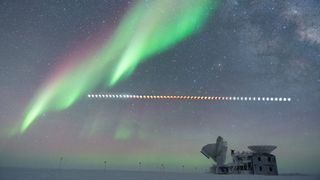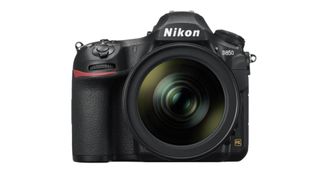South Pole aurora dances around total lunar eclipse in stunning astronomer photo
Astronomer Aman Chokshi took this image of the May Super Flower Blood Moon eclipse above the South Pole Telescope in Antarctica.

This stunning time-lapse photograph shows the May 15 total lunar eclipse above an astronomical observatory at the South Pole on the backdrop of magnificent auroras and the star-studded polar sky.
The lunar eclipse picture was taken by Aman Chokshi, a PhD astronomy student at the University of Melbourne, Australia, who is currently spending a year working at the South Pole Telescope in Antarctica, which studies microwave radiation emitted by the cosmos as part of the black-hole watching Event Horizon Telescope network.

Looking for a telescope for the next lunar eclipse? We recommend the Celestron Astro Fi 102 as the top pick in our best beginner's telescope guide.
"Last Monday we were lucky to see a total lunar eclipse from the South Pole," Chokshi told Space.com in an email. "The moon gradually dimmed and turned orange. It was crazy to see how the sky dimmed and the millions of stars of our Milky Way galaxy emerged. At the peak of the eclipse, a band of glowing auroras surged across the sky. A truly spectacular evening!"
Chokshi (whom you can see in the picture together with a friend waving into the camera from the edge of the roof of the telescope building), took the images that make up this time lapse over a 5-hour period.
Related: Amazing photos of the Super Flower Blood Moon lunar eclipse
"The background image is a single 20-second exposure with a sigma 24-70 millimeter lens, at f/2.8, iso 3200 on a Sony A7RVI, captured at the peak of the eclipse," Chokshi said. "The array of moon images were captured with an old sigma 400mm film lens, on a Sony A7S, on a skywatcher star adventurer tracker. The final composite image contains images of the moon every four minutes."
It took some courage and resourcefulness for Chokshi to take the images. The South Pole, currently nearing the peak of the winter period, is submerged in permanent darkness, and the polar expeditioners have to put up with some of the most extreme weather conditions one can experience on Earth.
Get the Space.com Newsletter
Breaking space news, the latest updates on rocket launches, skywatching events and more!

If you're looking for a good camera for meteor showers and astrophotography, our top pick is the Nikon D850. Check out our best cameras for astrophotography for more and prepare for the tau Herculids with our guide on how to photograph a meteor shower.
"We had a sustained wind of 15-20 knots, which brought the ambient temperature of minus 60 degrees Celsius [minus 76 degrees Fahrenheit] to minus 80 degrees C [minus 112 degrees F] with windchill," Chokshi said. "Both cameras had to be housed in special heated foam boxes which I made, to prevent them from freezing."
For more stunning South Pole and astronomy photography, follow Chokshi on Instagram @aman_chokshi
Editor's Note: If you snap an amazing photo of the moon or any other night sky sight and would like to share it with Space.com's readers, send your photo(s), comments, and your name and location to spacephotos@space.com.
Follow Tereza Pultarova on Twitter @TerezaPultarova. Follow us on Twitter @Spacedotcom and on Facebook.
Join our Space Forums to keep talking space on the latest missions, night sky and more! And if you have a news tip, correction or comment, let us know at: community@space.com.

Tereza is a London-based science and technology journalist, aspiring fiction writer and amateur gymnast. Originally from Prague, the Czech Republic, she spent the first seven years of her career working as a reporter, script-writer and presenter for various TV programmes of the Czech Public Service Television. She later took a career break to pursue further education and added a Master's in Science from the International Space University, France, to her Bachelor's in Journalism and Master's in Cultural Anthropology from Prague's Charles University. She worked as a reporter at the Engineering and Technology magazine, freelanced for a range of publications including Live Science, Space.com, Professional Engineering, Via Satellite and Space News and served as a maternity cover science editor at the European Space Agency.
